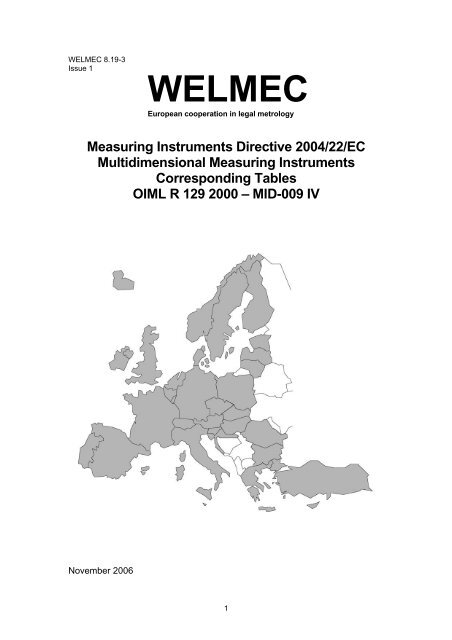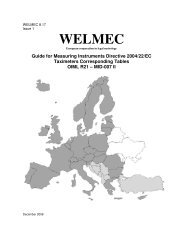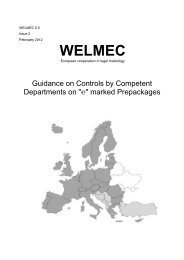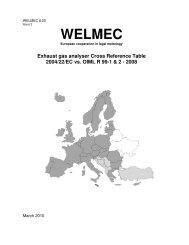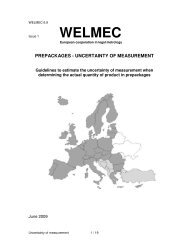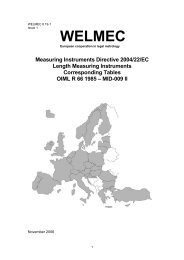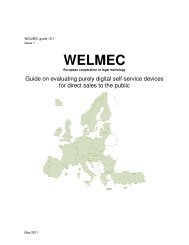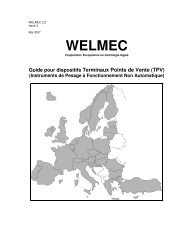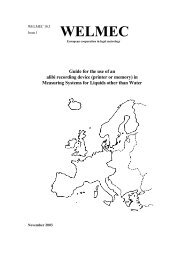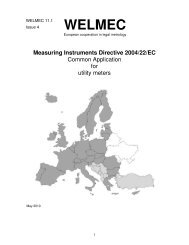Measuring Instruments Directive 2004/22/EC ... - WELMEC
Measuring Instruments Directive 2004/22/EC ... - WELMEC
Measuring Instruments Directive 2004/22/EC ... - WELMEC
Create successful ePaper yourself
Turn your PDF publications into a flip-book with our unique Google optimized e-Paper software.
WELM<strong>EC</strong> 8.19-3Issue 1WELM<strong>EC</strong>European cooperation in legal metrology<strong>Measuring</strong> <strong>Instruments</strong> <strong>Directive</strong> <strong>2004</strong>/<strong>22</strong>/<strong>EC</strong>Multidimensional <strong>Measuring</strong> <strong>Instruments</strong>Corresponding TablesOIML R 129 2000 – MID-009 IVNovember 20061
WELM<strong>EC</strong>European cooperation in legal metrologyWELM<strong>EC</strong> is a cooperation between the legal metrology services ofthe Member States of the European Union and EFTA. Thisdocument is one of a number of Guides published by WELM<strong>EC</strong> toprovide guidance to manufacturers of measuring instruments andto notified bodies responsible for conformity assessment of theirproducts. The Guides are purely advisory and do not themselvesimpose any restrictions or additional technical requirementsbeyond those contained in relevant <strong>EC</strong> <strong>Directive</strong>s. Alternativeapproaches may be acceptable, but the guidance provided in thisdocument represents the considered view of WELM<strong>EC</strong> as to thebest practice to be followed.Published by:WELM<strong>EC</strong> SecretariatFederal Office of Metrology and Surveying (BEV)Arltgasse 35A-1160 ViennaAustriaTel: +43 676 8210 3608Fax: +43 1 49 20 875 8006Email : welmec@bev.gv.atWebsite: www.welmec.org2
WELM<strong>EC</strong> WG 8 Guide 8.19-3 Issue 1FOREWORDThe <strong>Measuring</strong> <strong>Instruments</strong> <strong>Directive</strong> (MID) <strong>2004</strong>/<strong>22</strong>/<strong>EC</strong> entered into force on the 30 thOctober 2006. In this new approach directive the presumption of conformity ismentioned in Article 13. In addition to the use of harmonised standards (Art. 13 point 1)a new route is open for the presumption of conformity by using OIML recommendations(Art. 13 point 2).“Member States shall presume conformity with the essential requirements referred to inAnnex I and in the relevant instrument-specific Annexes in respect of a measuringinstruments that complies with the corresponding parts of the normative documents andlists referred to in Article 16(1)(a), the references in respect of which have beenpublished in the Official Journal of the European Union, C series.”Article 4(i) defines that“normative document” means a document containing technical specifications adoptedby the Organisation International de Métrologie Légale (OIML), subject to the procedurestipulated in Article 16(1)”.In Article 16 (1) (a) the functions of the <strong>Measuring</strong> <strong>Instruments</strong> Committee aredescribed as follows:“identify normative documents drawn up by OIML and, in a list, indicate the partsthereof compliance with which gives rise to a presumption of conformity with thecorresponding essential requirements of this <strong>Directive</strong>”.In the WELM<strong>EC</strong> Committee Meeting in May 2005 WELM<strong>EC</strong> agreed to support the workof the Commission on this issue and the MI-xxx Annexes of the MID has been given tothe Working Groups of WELM<strong>EC</strong> to develop corresponding tables including commentsas a basis for the publication foreseen in the <strong>Directive</strong>. A timetable has beenestablished and rules for drawing up these tables have been given by the WELM<strong>EC</strong>Committee. To prepare a proposal at least 3 experts has been involved. The draftshave been discussed in the responsible Working Group (including industry). The resultshave been sent do the WELM<strong>EC</strong> Secretariat and the WELM<strong>EC</strong> Committee Membershas been asked for Comments. These drafts have been discussed during theWELM<strong>EC</strong> Committee Meeting in May 2006 and have been adopted as WELM<strong>EC</strong>guides.The documents have been sent to the European Commission for further considerationand for drafting the publication required in the directive. This has been done in a smallWorking Group with the European Commission (June, July 2006).The European Commission presented the simplified tables to the Commission WorkingGroup on <strong>Measuring</strong> <strong>Instruments</strong> for further comment and subsequently obtained apositive advice from the <strong>Measuring</strong> <strong>Instruments</strong> Committee on 25 September 2006.The simplified tables are published In the Official Journal of the European Union, seriesC n° 269, p I of 4 November 2006. As guidance, WELM<strong>EC</strong> is publishing the full tableswith all the comments and detailed information underlying the simplified tables to aid allinterested and concerned parties.The European Commission webpage gives the link to the documents of WELM<strong>EC</strong>.3
WELM<strong>EC</strong> WG 8 Guide 8.19-3 Issue 1Table of correspondenceRequirement of MID Annex 1, MI 009 (Multidimensional <strong>Measuring</strong> <strong>Instruments</strong>) and OIML R 129 (2000)<strong>Directive</strong> <strong>2004</strong>/<strong>22</strong>/<strong>EC</strong> Essential requirements of Annex 1 and common partand chapter IV of Annex MI-009OIML R1292000CommentsANNEX 1ESSENTIAL REQUIREMENTSA measuring instrument shall provide a high level of metrological protection inorder that any party affected can have confidence in the result of measurement,and shall be designed and manufactured to a high level of quality in respect ofthe measurement technology and security of the measurement data.The requirements that shall be met by measuring instruments are set out belowand are supplemented, where appropriate, by specific instrument requirements inAnnexes MI-001 to MI-010 that provide more detail on certain aspects of thegeneral requirements.The solutions adopted in the pursuit of the requirements shall take account of theintended use of the instrument and any foreseeable misuse thereof.DEFINITIONSMeasurandThe measurand is the particular quantity subject to measurement.Influence quantityAn influence quantity is a quantity that is not the measurand but that affects theresult of measurement.III + 6.1-6.3VIM ,R 129 2.12VIM 2.7,R 129 2.29Also objective of OIMLComment only, see details belowAlso objective of OIMLVIM (reference document shared by BIPM,I<strong>EC</strong>,IFCC,ISO,IUPAC,IUAPP,OIML)Page 1/14Final version adopted by WELM<strong>EC</strong> Committe reviewed after adoption of cross references by the Commission September 2006
WELM<strong>EC</strong> WG 8 Guide 8.19-3 Issue 1Rated Operating ConditionsThe rated operating conditions are the values for the measurand and influencequantities making up the normal working conditions of an instrument.DisturbanceAn influence quantity having a value within the limits specified in the appropriaterequirement but outside the specified rated operating conditions of the measuringinstrument. An influence quantity is a disturbance if for that influencequantity the rated operating conditions are not specified.Critical change valueThe critical change value is the value at which the change in the measurementresult is considered undesirable.Material MeasureA material measure is a device intended to reproduce or supply in a permanentmanner during its use one or more known values of a given quantity.Direct salesA trading transaction is direct sales if:– the measurement result serves as the basis for the price to pay and;– at least one of the parties involved in the transaction related to measurementis a consumer or any other party requiring a similar level of protection and;– all the parties in the transaction accept the measurement result at that timeand place.Climatic environmentsClimatic environments are the conditions in which measuring instruments maybe used. To cope with climatic differences between the Member States, a rangeof temperature limits has been defined.UtilityA utility is regarded as a supplier of electricity, gas, heat or water.2.30 There is a difference in the text, but the principle is the same2.29.<strong>22</strong>.272.287.1.b)2 nd sentence is a commentCCV corresponds to significant faultWith the editorial difference that CCV is a limit where SF correspondsto all errors beyond the limitNot Applicable to Multidimensional <strong>Measuring</strong> <strong>Instruments</strong>Indicator and printing device requirementConditions given in R 129 5.1 and 5.2Not Applicable to Multidimensional <strong>Measuring</strong> <strong>Instruments</strong>1. Allowable ErrorsPage 2/14Final version adopted by WELM<strong>EC</strong> Committe reviewed after adoption of cross references by the Commission September 2006
WELM<strong>EC</strong> WG 8 Guide 8.19-3 Issue 11.1. Under rated operating conditions and in the absence of a disturbance, theerror of measurement shall not exceed the maximum permissible error(MPE) value as laid down in the appropriate instrument-specific requirements.Unless stated otherwise in the instrument-specific annexes, MPE is expressedas a bilateral value of the deviation from the true measurementvalue1.2. Under rated operating conditions and in the presence of a disturbance, theperformance requirement shall be as laid down in the appropriate instrumentspecific requirements.2.26, 4.2 and11.1.4.3MID (Article 4(f)) –“putting into use”, OIML R 129 “Initial verification”VIM 5.21,See also R 129 2.23-2.26 for definitions of errorsMPE = ± 1,0⋅d.In contradiction to MID: R 129, 2.28: ”significant fault > d”.Where the instrument is intended to be used in a specified permanent continuouselectromagnetic field the permitted performance during the radiatedelectromagnetic field-amplitude modulated test shall be within MPE.1.3. The manufacturer shall specify the climatic, mechanical and electromagneticenvironments in which the instrument is intended to be used, powersupply and other influence quantities likely to affect its accuracy, takingaccount of the requirements laid down in the appropriate instrumentspecificannexes.1.3.1. Climatic environmentsThe manufacturer shall specify the upper temperature limit and the lowertemperature limit from any of the values in Table 1 unless otherwisespecified in the annexes MI-001 to MI-010, and indicate whether the instrumentis designed for condensing or non-condensing humidity as wellas the intended location for the instrument, i.e. open or closed.Table 1Temperature LimitsUpper temperature limit 30 °C 40 °C 55 °C 70 °CLower temperature limit 5 °C - 10 °C - 25 °C - 40 °CA.3.4 and 2.28Annex A5.1 and 5.2 Non-condensingManufacturer to specify U/L temp limits, rest is specified inAnnex A.Humidity 85% at 40 °C or specified upper temperature limitThe terms condensing or non-condensing humidity and intendedlocation are not mentioned in OIML R 129 in the sense of MID.Manufacturer specify or -10 to 40 °CRange of temperature limits, if specified, shall be at least 30 °C(R 129 5.1)1.3.2. (a) Mechanical environments are classified into classes M1 to M3 asdescribed below.Page 3/14Final version adopted by WELM<strong>EC</strong> Committe reviewed after adoption of cross references by the Commission September 2006
WELM<strong>EC</strong> WG 8 Guide 8.19-3 Issue 1M1 This class applies to instruments used in locations with vibrationand shocks of low significance, e.g. for instruments fastenedto light supporting structures subject to negligible vibrationsand shocks transmitted form local blasting or pile-drivingactivities, slamming doors, etc.None such tests described in R129.Every class may be appropriate.M2 This class applies to instruments used in locations with significantor high levels of vibration and shock, e.g. transmittedfrom machines and passing vehicles in the vicinity or adjacentto heavy machines, conveyor belts, etc.M3 This class applies to instruments used in locations where thelevel of vibration and shock is high and very high, e.g. for instrumentsmounted directly on machines, conveyor belts, etc.(b) The following influence quantities shall be considered in relationwith mechanical environments:– Vibration;– Mechanical shock.1.3.3. (a) Electromagnetic environments are classified into classes E1, E2 orE3 as described below, unless otherwise laid down in the appropriateinstrument-specific annexes.E1 This class applies to instruments used in locations with electromagneticdisturbances corresponding to those likely to befound in residential, commercial and light industrial buildings.E2 This class applies to instruments used in locations with electromagneticdisturbances corresponding to those likely to befound in other industrial buildings.5.3., 11.1.4.4andAnnex A.3Vibration only.OIML R 129 does not refer to the abbreviations used in MID, but theprinciple is identical.This class may be appropriateThis class would be appropriate.Page 4/14Final version adopted by WELM<strong>EC</strong> Committe reviewed after adoption of cross references by the Commission September 2006
WELM<strong>EC</strong> WG 8 Guide 8.19-3 Issue 1E3 This class applies to instruments supplied by the battery of avehicle. Such instruments shall comply with the requirementsof E 2 and the following additional requirements:– voltage reductions caused by energising the starter-motorcircuits of internal combustion engines– load dump transients occurring in the event of a dischargedbattery being disconnected while the engine isrunning.(b) The following influence quantities shall be considered in relationwith electromagnetic environments:– Voltage interruptions,– Short voltage reductions,– Voltage transients on supply lines and/or signal lines,– Electrostatic discharges,– Radio frequency electromagnetic fields,– Conducted radio frequency electromagnetic fields on supplylines and/or signal lines,– Surges on supply lines and/or signal lines.1.3.4. Other influence quantities to be considered, where appropriate, are:– Voltage variation,– Mains frequency variation,– Power frequency magnetic fields,– Any other quantity likely to influence in a significant way the accuracyof the instrument.5.3, 11.1.4.4and Annex A.3Not Applicable to Multidimensional <strong>Measuring</strong> <strong>Instruments</strong>Requirements specified in OIML R 129 5.3, 11.1.4.4Test procedures is specified in OIML R 129 Annex A.35.1 and A.2.3. Requirements specified in OIML R 129 5.1.Test procedures is specified in OIML R 129 Annex A.2.31.4. When carrying out the tests as envisaged in this <strong>Directive</strong>, the followingparagraphs apply:Page 5/14Final version adopted by WELM<strong>EC</strong> Committe reviewed after adoption of cross references by the Commission September 2006
WELM<strong>EC</strong> WG 8 Guide 8.19-3 Issue 11.4.1. Basic rules for testing and the determination of errorsEssential requirements specified in 1.1 and 1.2 shall be verified for eachrelevant influence quantity. Unless otherwise specified in the appropriateinstrument-specific annex, these essential requirements apply when eachinfluence quantity is applied and its effect evaluated separately, all otherinfluence quantities being kept relatively constant at their reference value.Metrological tests shall be carried out during or after the application of theinfluence quantity, whichever condition corresponds to the normal operationalstatus of the instrument when that influence quantity is likely to occur.1.4.2. Ambient humidity5.3. and A.1.1and A.1.2R129 in conformity with the philosophy in MID.– According to the climatic operating environment in which the instrumentis intended to be used either the damp heat-steady state (noncondensing)or damp heat cyclic (condensing) test may be appropriate.5.2 and A.2.2 Only steady state is foreseen.– The damp heat cyclic test is appropriate where condensation is importantor when penetration of vapour will be accelerated by the effect ofbreathing. In conditions where non-condensing humidity is a factor thedamp-heat steady state is appropriate.2. ReproducibilityThe application of the same measurand in a different location or by a differentuser, all other conditions being the same, shall result in the closeagreement of successive measurements. The difference between the measurementresults shall be small when compared with the MPE.Reproducibility is a necessary requirement for Multidimensional<strong>Measuring</strong> <strong>Instruments</strong>. Reproducibility is not mentioned in R 129.Page 6/14Final version adopted by WELM<strong>EC</strong> Committe reviewed after adoption of cross references by the Commission September 2006
WELM<strong>EC</strong> WG 8 Guide 8.19-3 Issue 13. RepeatabilityThe application of the same measurand under the same conditions ofmeasurement shall result in the close agreement of successive measurements.The difference between the measurement results shall be smallwhen compared with the MPE.4. Discrimination and SensitivityA measuring instrument shall be sufficiently sensitive and the discriminationthreshold shall be sufficiently low for the intended measurement task.Repeatability is a necessary requirement for Multidimensional<strong>Measuring</strong> <strong>Instruments</strong>. Repeatability is not mentioned in R 129.Also objective of OIML R1295. DurabilityA measuring instrument shall be designed to maintain an adequate stabilityof its metrological characteristics over a period of time estimated bythe manufacturer, provided that it is properly installed, maintained andused according to the manufacturer's instruction when in the environmentalconditions for which it is intended.6.26. ReliabilityA measuring instrument shall be designed to reduce as far as possible theeffect of a defect that would lead to an inaccurate measurement result,unless the presence of such a defect is obvious.Reliability is not mentioned in R 129.7. Suitability7.1. A measuring instrument shall have no feature likely to facilitate fraudulentuse, whereas possibilities for unintentional misuse shall be minimal. 6.17.2. A measuring instrument shall be suitable for its intended use taking accountof the practical working conditions and shall not require unreasonabledemands of the user in order to obtain a correct measurement result.6.2Page 7/14Final version adopted by WELM<strong>EC</strong> Committe reviewed after adoption of cross references by the Commission September 2006
WELM<strong>EC</strong> WG 8 Guide 8.19-3 Issue 17.3. The errors of a utility measuring instrument at flows or currents outsidethe controlled range shall not be unduly biased.7.4. Where a measuring instrument is designed for the measurement of valuesof the measurand that are constant over time, the measuring instrumentshall be insensitive to small fluctuations of the value of the measurand, orshall take appropriate action.Not Applicable to Multidimensional <strong>Measuring</strong> <strong>Instruments</strong>Not Applicable to Multidimensional <strong>Measuring</strong> <strong>Instruments</strong>7.5. A measuring instrument shall be robust and its materials of constructionshall be suitable for the conditions in which it is intended to be used. 6.27.6. A measuring instrument shall be designed so as to allow the control of themeasuring tasks after the instrument has been placed on the market andput into use. If necessary, special equipment or software for this controlshall be part of the instrument. The test procedure shall be described in theoperation manual.When a measuring instrument has associated software which providesother functions besides the measuring function, the software that is criticalfor the metrological characteristics shall be identifiable and shall not beinadmissibly influenced by the associated software.8. Protection against corruption8.1. The metrological characteristics of a measuring instrument shall not beinfluenced in any inadmissible way by the connection to it of another device,by any feature of the connected device itself or by any remote devicethat communicates with the measuring instrument.8.2. A hardware component that is critical for metrological characteristics shallbe designed so that it can be secured. Security measures foreseen shallprovide for evidence of an intervention.6.310.4 and 9.210.49.2Page 8/14Final version adopted by WELM<strong>EC</strong> Committe reviewed after adoption of cross references by the Commission September 2006
WELM<strong>EC</strong> WG 8 Guide 8.19-3 Issue 18.3. Software that is critical for metrological characteristics shall be identifiedas such and shall be secured.Software identification shall be easily provided by the measuring instrument.9.2 OIML R 129 9.2 Listing requirements for software sealing.WELM<strong>EC</strong> 7.2 “Software Guide”, May 2005, may be helpful.Evidence of an intervention shall be available for a reasonable period oftime.8.4. Measurement data, software that is critical for measurement characteristicsand metrologically important parameters stored or transmitted shall be adequatelyprotected against accidental or intentional corruption.8.5. For utility measuring instruments the display of the total quantity supplied orthe displays from which the total quantity supplied can be derived, whole orpartial reference to which is the basis for payment, shall not be able to be resetduring use.9.2 Requirements for software sealing listed in OIML R 129 9.2.Not Applicable to Multidimensional <strong>Measuring</strong> <strong>Instruments</strong>9. Information to be borne by and to accompany the instrument9.1. A measuring instrument shall bear the following inscriptions:– manufacturer's mark or name;– information in respect of its accuracy,plus, when applicable:8.1 Requirements Listed in R 129 8.1– information in respect of the conditions of use;– measuring capacity;– measuring range;– identity marking;– number of the <strong>EC</strong>-type examination certificate or the <strong>EC</strong> design examinationcertificate;– information whether or not additional devices providing metrologicalresults comply with the provisions of this <strong>Directive</strong> on legal metrologicalcontrol.Page 9/14Final version adopted by WELM<strong>EC</strong> Committe reviewed after adoption of cross references by the Commission September 2006
WELM<strong>EC</strong> WG 8 Guide 8.19-3 Issue 19.2. An instrument of dimensions too small or of too sensitive a composition toallow it to bear the relevant information shall have its packaging, if any,and the accompanying documents required by the provisions of this <strong>Directive</strong>suitably marked.9.3. The instrument shall be accompanied by information on its operation,unless the simplicity of the measuring instrument makes this unnecessary.Information shall be easily understandable and shall include where relevant:Not Applicable to Multidimensional <strong>Measuring</strong> <strong>Instruments</strong>8.1 and 8.2 Requirements Listed in R 129 8.1 and 8.2– rated operating conditions;– mechanical and electromagnetic environment classes;– the upper and lower temperature limit, whether condensation is possibleor not, open or closed location;– instructions for installation, maintenance, repairs, permissible adjustments;– instructions for correct operation and any special conditions of use;– conditions for compatibility with interfaces, sub-assemblies or measuringinstruments.9.4. Groups of identical measuring instruments used in the same location orused for utility measurements do not necessarily require individual instructionmanuals.This requirement is not mentioned in R 129.9.5. Unless specified otherwise in an instrument-specific annex, the scale intervalfor a measured value shall be in the form 1x10 n , 2x10 n , or 5x10 n ,where n is any integer or zero. The unit of measurement or its symbolshall be shown close to the numerical value.7.49.6 A material measure shall be marked with a nominal value or a scale, accompaniedby the unit of measurement used.Not Applicable to Multidimensional <strong>Measuring</strong> <strong>Instruments</strong>9.7. The units of measurement used and their symbols shall be in accordancewith the provisions of Community legislation on units of measurementand their symbols.3Page 10/14Final version adopted by WELM<strong>EC</strong> Committe reviewed after adoption of cross references by the Commission September 2006
WELM<strong>EC</strong> WG 8 Guide 8.19-3 Issue 19.8. All marks and inscriptions required under any requirement shall be clear,non-erasable, unambiguous and non-transferable. 8.110. Indication of result10.1. Indication of the result shall be by means of a display or hard copy. 7.1 Indicator or printer:Se comments to 10.3 and 11.110.2. The indication of any result shall be clear and unambiguous and accompaniedby such marks and inscriptions necessary to inform the user of thesignificance of the result. Easy reading of the presented result shall bepermitted under normal conditions of use. Additional indications may beshown provided they cannot be confused with the metrologically controlledindications.7.2 and 7.910.3. In the case of hard copy the print or record shall also be easily legible andnon-erasable. 7.9A record is not mentioned in R 129.10.4. A measuring instrument for direct sales trading transactions shall be designedto present the measurement result to both parties in the transactionwhen installed as intended. When critical in case of direct sales, any ticketprovided to the consumer by an ancillary device not complying with theappropriate requirements of this <strong>Directive</strong> shall bear an appropriate restrictiveinformation.7.1.b10.5. Whether or not a measuring instrument intended for utility measurementpurposes can be remotely read it shall in any case be fitted with a metrologicallycontrolled display accessible without tools to the consumer.The reading of this display is the measurement result that serves as the basisfor the price to pay.Not Applicable to Multidimensional <strong>Measuring</strong> <strong>Instruments</strong>11. Further processing of data to conclude the trading transactionPage 11/14Final version adopted by WELM<strong>EC</strong> Committe reviewed after adoption of cross references by the Commission September 2006
WELM<strong>EC</strong> WG 8 Guide 8.19-3 Issue 111.1. A measuring instrument other than a utility measuring instrument shallrecord by a durable means the measurement result accompanied by informationto identify the particular transaction, when:– the measurement is non-repeatable and;– the measuring instrument is normally intended for use in the absenceof one of the trading parties.11.2. Additionally, a durable proof of the measurement result and the informationto identify the transaction shall be available on request at the time themeasurement is concluded.12. Conformity evaluation7.97.9 note 2Storing of measurement results and identification is not specificallymentioned in R 129.A measuring instrument shall be designed so as to allow ready evaluationof its conformity with the appropriate requirements of this <strong>Directive</strong>.6.3 There is a difference in the text, but the principle is the sameANNEX MI-009DIMENSIONAL MEASURING INSTRUMENTSHere Multi Dimensional <strong>Measuring</strong> <strong>Instruments</strong>The relevant essential requirements of Annex I, the specific requirements of thisAnnex and the conformity assessment procedures listed in this Annex, apply todimensional measuring instruments of the types defined below.DEFINITIONSMulti-dimensional <strong>Measuring</strong> <strong>Instruments</strong>A multi-dimensional measuring instrument serves for the determination of theedge length (length, height, width) of the smallest enclosing rectangular parallelepipedof a product.2.1 Not the same text, but in conformity with MIDCHAPTER IRequirements common to all dimensional measuring instrumentsPage 12/14Final version adopted by WELM<strong>EC</strong> Committe reviewed after adoption of cross references by the Commission September 2006
WELM<strong>EC</strong> WG 8 Guide 8.19-3 Issue 1Electromagnetic immunity1. The effect of an electromagnetic disturbance on a dimensional measuring instrumentshall be such that:— the change in measurement result is no greater than the critical change valueas defined in paragraph 2.3; or— it is impossible to perform any measurement; or— there are momentary variations in the measurement result that cannot be interpreted,memorised or transmittedas a measuring result; or— there are variations in the measurement result severe enough to be noticed byall those interested in themeasurement result.2. The critical change value is equal to one scale interval.5.3, A32.28In contradiction to MID: R 129, 2.28: ”significant fault > d”.CHAPTER IV — Multidimensional measuring instrumentsOperating conditions1.1. R a n g eDimensions within the range specified by the manufacturer for the instrument. 4.12.162.151.2. M i n i mu m d i me n s i o nThe lower limit of the minimum dimension for all values of the scale interval isgiven in Table 1. 4.1 Same table in R 129 4.1Minimum dimensions depending on scale interval.Limits for maximum dimensions defined by the manufacturerPage 13/14Final version adopted by WELM<strong>EC</strong> Committe reviewed after adoption of cross references by the Commission September 2006
WELM<strong>EC</strong> WG 8 Guide 8.19-3 Issue 11.3. S p e e d o f t h e p r o d u c tThe speed must be within the range specified by the manufacturer for the instrument.MPE2. I n s t r u me n t :The MPE is ± 1,0 d.2.8, 11.1.4.7and A1.5.4.2 MPE is ± 1,0 d for any of the three dimensionsPage 14/14Final version adopted by WELM<strong>EC</strong> Committe reviewed after adoption of cross references by the Commission September 2006


